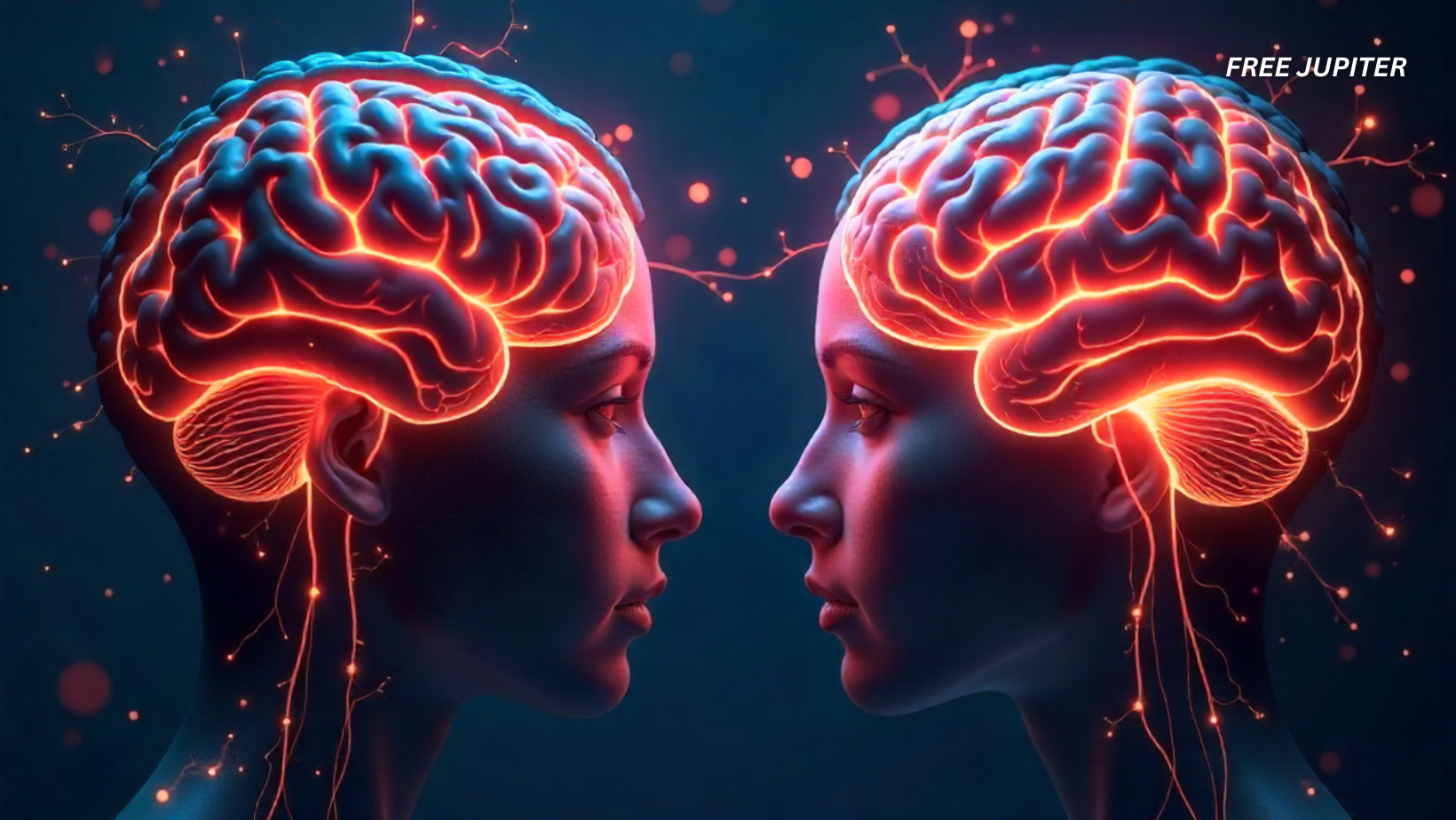Friendly Note: FreeJupiter.com shares general info for curious minds 🌟 Please fact-check all claims—and always check health matters with a professional 💙
For most of human history, people have been convinced they are separate—each mind its own private island, locked away behind the walls of the skull. But now, researchers are hinting that this might not be the whole truth.
According to recent findings from Princeton University, our brains might be doing something quietly astonishing: broadcasting ultra-low-frequency electromagnetic waves that could link us—subtly, invisibly—across thousands of miles. These faint brain signals, scientists say, may form a kind of planetary neural network.
If true, it would mean that your brain, right now, could be influencing another person on the opposite side of the Earth—and vice versa—without either of you being aware of it. No wires. No internet. Just the quiet hum of biology interacting with the physics of the planet.
Your Brain, the Reluctant Radio
To understand this, we need to take a brief tour inside your head. The human brain is an electrical organ. Every second, billions of neurons send tiny electrical pulses through delicate networks, enabling thoughts, memories, emotions, and the constant chatter of inner life.
Like any electrical current, this activity produces electromagnetic fields. Normally, these fields are incredibly weak—measured in microvolts—and they’re thought to be limited to your own head. But the Princeton research zeroed in on something different: ultra-low-frequency (ULF) electromagnetic waves.
These are not the “brainwaves” you hear about in meditation podcasts. Alpha, beta, and gamma waves have relatively high frequencies and short ranges. ULF waves, on the other hand, operate at just a few cycles per second—or even fractions of a cycle. They’re slower, subtler, and capable of traveling through the Earth’s atmosphere and crust for vast distances.
In practical terms, your brain might be producing a barely perceptible signal that, under the right conditions, could ripple halfway around the planet.
Read more: After Half a Century, Scientists Finally Catch The Elusive ‘Ghost Particles’
The Physics That Makes It Possible
If this sounds far-fetched, remember: ultra-low-frequency signals are already used in technology for long-distance communication. Submarines, for example, rely on ULF transmissions to send coded messages through seawater, which would block normal radio waves.
The secret is in how ULF waves interact with the Earth’s magnetic field and the ionosphere (the charged upper layer of the atmosphere). These natural structures act like waveguides, helping the signal bounce or flow around the globe without much loss of strength.
So, in theory, a brain-generated ULF signal—though much weaker than a military transmitter—could still ride these natural pathways and become detectable far away.
Synchronized Minds: The Princeton Findings
In their experiments, Princeton researchers looked at brainwave data from participants spread across different regions. They noticed something intriguing: at certain times, the ultra-low-frequency brain patterns of individuals thousands of kilometers apart appeared to align.
This kind of synchronization wasn’t random. It seemed to follow a pattern, as if multiple brains were “tuning in” to the same underlying rhythm—despite no physical contact, no shared environment, and no direct communication.
While this doesn’t prove minds are exchanging specific information, it does suggest a shared, measurable influence—like faintly tapping your foot to a beat you can’t quite hear but somehow feel.
A History of “Shared Mind” Ideas
The notion that human minds might be connected isn’t new—it’s been echoed in spiritual traditions, folklore, and speculative science for centuries.
- Carl Jung’s Collective Unconscious: Jung proposed that humans share a deep layer of the psyche filled with universal archetypes and symbols. While philosophical in nature, the Princeton findings could be seen as a physical underpinning for such an idea.
- Telepathy Experiments in the Early 20th Century: Though many lacked scientific rigor, some early studies hinted at nonverbal information transfer between people.
- The Global Consciousness Project: Running since the late 1990s, this Princeton-based project monitors random number generators worldwide. Its operators claim to see patterns in the data during major global events—like 9/11 or the 2004 tsunami—suggesting a shared human response on a subtle, measurable level.
Now, modern neuroscience is starting to add hard physics to a conversation that once belonged solely to philosophy and pseudoscience.
Read more: The Shocking Factor Holding AI Back From Replacing Humans
Could This Influence Our Feelings and Ideas?
If human brains are indeed connected through ULF waves, the implications are profound. It could mean that moods, creativity, or even problem-solving abilities might not be entirely individual.
Consider:
- Emotional Contagion: We know emotions spread quickly in groups—laughter is contagious, panic can ripple through crowds. Could a similar, ultra-subtle effect be happening across continents?
- Global “Brain Weather”: Just as weather patterns affect multiple regions, there might be mental or emotional “climates” shaped by this hidden network.
- Shared Insight: History is full of examples where multiple inventors, working independently, made the same breakthrough at nearly the same time. Perhaps some of that synchronicity is more than coincidence.
Why We Haven’t Noticed
If these connections exist, why haven’t we felt them directly? The answer might be that they operate below the threshold of conscious awareness.
Our brains are constantly bombarded with sensory input—light, sound, touch—and internal chatter. A faint ultra-low-frequency signal could easily slip under the radar, subtly influencing thought patterns or emotional tone without registering as an obvious “message.”
In this way, the global neural network would be less like a spoken conversation and more like a background hum, gently nudging us in ways we might not even realize.
The Skeptical Lens
It’s important to note that the science is far from settled. Measuring brain-generated ULF waves is notoriously challenging. There’s always a risk of confusing them with environmental noise—from power grids, electronics, or even natural phenomena like lightning strikes.
Critics also point out that synchronized brain activity could be caused by shared environmental factors rather than a direct brain-to-brain link. For example, two people in different countries might both respond to the same news headline, leading to similar brainwave patterns without any mysterious connection.
Still, the Princeton team argues that their data remains intriguing—and worth exploring further.
If True, What Then?
If future research confirms that our brains are part of a planetary-scale electromagnetic network, we’d have to rethink what it means to be an individual thinker.
It wouldn’t erase personal identity, but it might reveal that every mind is also a node in a vast, slow-moving conversation. We’d be, in a sense, co-authors of each other’s mental landscapes.
This could have fascinating—and perhaps even practical—applications:
- Mental Health: Could collective “brain weather” influence rates of anxiety or depression? If so, could tuning the global network help?
- Creativity and Innovation: If ideas can ripple subtly through this network, global collaboration might be happening in ways we’ve never consciously harnessed.
- Human Unity: Knowing that we’re all connected—quite literally—could shift cultural perspectives toward greater empathy and cooperation.
Read more: Humans Have Lost 60% of Their Connection With Nature in Just Two Centuries, Study Shows
The Quiet Chorus of Minds
Right now, you may be alone in your room, reading these words. But if the Princeton research is correct, you are never truly alone. Your brain may be part of a low, continuous conversation with millions of others—a whisper beneath the noise of daily life, carried on invisible waves around the Earth.
We might not yet know the words of this conversation. We may never fully decode its meaning. But perhaps, deep down, some part of us has always known it was there—like a melody half-remembered, waiting to be heard again.
And if that’s the case, then the next time you feel a sudden shift in mood, a burst of inspiration, or a strange sense of connection to the world at large… it might not just be you.
It could be the planet, humming softly, and every mind on it humming back.










